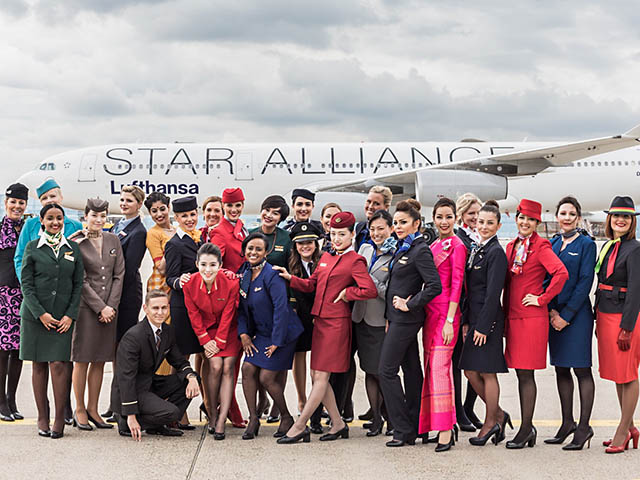
[ad_1]
The International Air Transport Association (IATA) published its statistics for the year 2018, which indicate that global air connectivity becomes " even more accessible and more efficient ". Among the series of rankings revealed is the role of low cost and the region Asia Pacific, the first placeAmerican Airlines in offer in seats, and the fact that Hong Kong is home to the two densest international routes in the world.
IATA Global Air Transport Statistics (WATS 2019) confirm that 4.4 billion passengers flew in 2018 on scheduled flights (+ 6.9%); that a record level of efficiency has been achieved, while 81.9% seats offered were actually occupied; than energy efficiency improved by more than 12% compared to 2010; than 22,000 pairs of cities are now linked by direct links (a figure up 1300 from 2017, and more than double the 10,250 city pairs of 1998); and that the real cost Air transport has been reduced by more than half in the last 20 years (to be around US $ 0.78 per revenue tonne-kilometer, or RTK).
" Airlines connect more people and places than ever before. The freedom to fly is more accessible than ever. And our world is more prosperous Said in a statement Alexandre de Juniac, Director General and CEO of IATA. Who reminds that " like any human activity, aviation has a environmental cost that airlines are determined to reduce. We understand that sustainability is essential to ensure our license to deliver the benefits of aviation. Starting in 2020, we will cap the growth of net carbon emissions. And by 2050, we will halve our carbon footprint, compared to the 2005 level. These ambitious climate goals require the support of governments. This support is critical for the advent of sustainable aviation fuels, new technologies and more efficient routes for a greener future towards which we strive. ".
The development of the segment low cost carriers continues at a faster pace than regular airlines: measured in available seat-kilometers (ASK), LCC capacity 13.4%almost double the growth rate of the industry as a whole (6.9%). Low cost accounted for 21% of global capacity in 2018, up from 11% in 2004. Looking at the seats offered, the global share of LCCs in 2018 was 29%, "reflecting the Short-haul nature of their business model "(16% of the market in 2004). Some 52 of the 290 airlines currently members of IATA say they belong to the "LCC category or another new business model".
The airlines of the Asia-Pacific region transported the largest number of passengers. The regional ranking (based on the total number of passengers carried on scheduled flights by airlines registered in the region) is as follows:
1. Asia Pacific : 37.1% of market share (1.6 billion passengers, up 9.2% compared to the number of passengers in the region in 2017).
2. Europe : 26.2% of market share (1.1 billion passengers, up 6.6% from 2017).
3. North America : 22.6% of the market share (989.4 million passengers, up 4.8% compared to 2017).
4. Latin America : 6.9% of market share (302.2 million passengers, up 5.7% compared to 2017).
5. Middle East : 5.1% of market share (224.2 million passengers, up 4.0% compared to 2017).
6. Africa : 2.1% of market share (92 million passengers, up 5.5% compared to 2017).
The five largest airlines, ranked by total number of passenger-kilometers on scheduled flights:
1. American Airlines (330.6 billion)
2. Delta Air Lines (330 billion)
3. United Airlines (329.6 billion)
4. Emirates (302.3 billion)
5. Southwest Airlines (214.6 billion)
The five main pairs of airports in terms of international passengers and Regional (O-D), all in the Asia-Pacific region again this year:
1. Hong Kong – Taipei-Taoyuan (5.4 million, down 0.4% from 2017)
2. Bangkok Suvarnabhumi – Hong Kong (3.4 million, up 8.8% from 2017)
3. Jakarta Soekarno-Hatta – Singapore Changi (3.2 million, down 3.3% from 2017)
4. Seoul-Incheon – Osaka-Kansai (2.9 million, up 16.5% from 2017)
5. Kuala Lumpur International – Singapore Changi ($ 2.8 million, up 2.1% from 2017).
The five main pairs of airports for the domestic passengers were also in the Asia-Pacific region:
1. Jeju – Seoul Gimpo (14.5 million, up 7.6% from 2017)
2. Fukuoka – Tokyo-Haneda (7.6 million, up 0.9% from 2017)
3. Melbourne – Sydney (7.6 million, down 2.1% from 2017)
4. Sapporo – Tokyo-Haneda (7.3 million, down 1.5% from 2017)
5. Pekin (Beijing Capital) – Shanghai-Hongqiao (6.4 million, up 0.4%
report to 2017)
The five main nationalities on international routes :
• United Kingdom (126.2 million, or 8.6% of all passengers)
• United States (111.5 million, or 7.6% of all passengers)
• People's Republic of China (97 million, or 6.6% of all passengers)
• Germany (94.3 million, or 6.4% of all passengers)
• France (59.8 million, or 4.1% of all passengers)
After a very strong year 2017, air cargo volumes have, according to IATA, more modest growth in 2018, reflecting global trade volumes. Globally, the number of tonne-kilometers (FTK) of merchandise and mail increased 3.4% compared to 9.7% in 2017. As capacity increased by 5.2% in 2018, load factor lost 0.8 percentage points to 49.3%. The top five airlines ranked by number of tonne-kilometers on scheduled flights:
• Federal Express (17.5 billion)
• Emirates (12.7 billion)
• Qatar Airways (12.7 billion)
• United Parcel Service (UPS, 12.5 billion)
• Cathay Pacific Airways (11.3 billion)
Finally Star Alliance maintained its position as the largest alliance of airlines in 2018, with 21.9% of total scheduled traffic (in RPK). Then come SkyTeam (18.8%) and Oneworld (15.4%).

© Star Alliance
https://www.air-journal.fr/2019-08-01-le-transport-aerien-en-2018-selon-liata-5214106.html
Source link